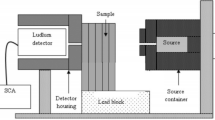Abstract
This paper reports the novel use of almond gum as a binder in manufacturing Rhizophora spp. particleboard. X-ray fluorescence spectroscopy was employed for analysis under photon energy range of 16.6–25.3 keV. Results showed that almond gum-bonded Rhizophora spp. particleboard can be used as tissue-equivalent phantom in diagnostic radiation. The calculated mass attenuation coefficients of the particleboards were consistent with the values of water calculated using XCOM program for the same photon energies, with p values of 0.056, 0.069, and 0.077 for samples A8, C0, and C8, respectively. However, no direct relationship was found between the percentage of adhesive and the mass attenuation coefficient. The results positively supported the use of almond gum as a binding agent in the fabrication of particleboards, which can be used as a phantom material in dosimetric and quality control applications.



Similar content being viewed by others
References
Hubbell J, Gerstenberg H, Saloman E (1986) Bibliography of photon total cross section (attenuation coefficient) measurements 10 eV to 13.5 GeV. National Bureau of Standards Internal Report NBSIR 86-3461. US Printing Office, Washington, DC
Kouris K, Spyrou NM (1978) Usefulness of photon mass attenuation coefficients in elemental analysis. Nucl Instrum Methods 153:477–483
Wang K, Zhao Y, Chang Y-H, Qian Z, Zhang C et al (2016) Controlling the mechanical behavior of dual-material 3D printed meta-materials for patient-specific tissue-mimicking phantoms. Mater Des 90:704–712
Sudin C, Tajuddin A, Bradley D (1988) Evaluation of tissue-equivalent media for dosimetric studies. In: Proceeding of local seminar activities on radiation physics, biophysics and medical physics, Kuala Lumpur, pp 71–80
Bradley D, Tajuddin A, Sudin CWACW, Bauk S (1991) Photon attenuation studies on tropical hardwoods. Int J Radiat Appl Instrum Part A 42:771–773
Tajuddin A, Sudin CCW, Bradley D (1996) Radiographic and scattering investigation on the suitability of Rhizophora spp. as tissue-equivalent medium for dosimetric study. Radiat Phys Chem 47:739–740
Shakhreet B, Bauk S, Tajuddin A, Shukri A (2009) Mass attenuation coefficients of natural Rhizophora spp. wood for X-rays in the 15.77–25.27 keV range. Radiat Prot Dosim 135:47–53
JIS (2003) Japanese industrial standard for particle board JIS A 5908. Japanese Standard Association, Japan
Surani B (2008) The suitability of PF, UF, and PRF resins in terms of structure and attenuation properties to be used in Rhizophora spp. particleboard phantom. M.Sc. Thesis, Universiti Sains Malaysia
Ngu K (2009) Fabrication of 1.0 g/cm3 Rhizophora spp. particleboard and determination of their mass attenuation coefficient. M.Sc. Thesis, Universiti Sains Malaysia
Berger M, Hubbell J (1987) XCOM: photon cross sections database. Web Version 1.2. National Institute of Standards and Technology, Gaithersburg, MD 20899
Rokiah H, Hazneza AS, Othman S, Norli I, Hakimi IM et al (2009) Extractable formaldehyde from waste medium density fibreboard. J Tropi For Sci 21(1):25–33
Marashdeh M, Bauk S, Tajuddin A, Hashim R (2012) Measurement of mass attenuation coefficients of Rhizophora spp. binderless particleboards in the 16.59–25.26 keV photon energy range and their density profile using X-ray computed tomography. Appl Radiat Isot 70:656–662
Abuarra A, Bauk S, Hashim R, Kandaiya S, Tousi ET et al (2014) XRF technique for the evaluation of gum arabic bonded Rhizophora spp. particleboards as tissue equivalent material. Int J Appl Phys Math 4(3):201
Mahfoudhi N, Chouaibi M, Donsì F, Ferrari G, Hamdi S (2012) Chemical composition and functional properties of gum exudates from the trunk of the almond tree (Prunus dulcis). Food Sci Technol Int 18:241–250
Rahimi S, Abbasi S, Azizi MH, Sahari MA (2013) Characterization of an unknown exudate gum from Iran: Persian gum. In: 1st International e-Conference on Novel Food Processing (IECFP2013). Mashhad–Iran (Oral)
Constantinou C (1982) Phantom materials for radiation dosimetry. I. Liquids and gels. Br J Radiol 55:217–224
Tousi E, Bauk S, Hashim R, Jaafar M, Abuarra A et al (2014) Measurement of mass attenuation coefficients of Eremurus-Rhizophora spp. particleboards for X-ray in the 16.63–25.30 keV energy range. Radiat Phys Chem 103:119–125
Acknowledgments
The author wants to thank to Mr. Mohd Rizal School of physics, Universiti Sains Malaysia, for his helpful comments.
Author information
Authors and Affiliations
Corresponding author
Rights and permissions
About this article
Cite this article
Ababneh, B., Tajuddin, A.A., Hashim, R. et al. Investigation of mass attenuation coefficient of almond gum bonded Rhizophora spp. particleboard as equivalent human tissue using XRF technique in the 16.6–25.3 keV photon energy. Australas Phys Eng Sci Med 39, 871–876 (2016). https://doi.org/10.1007/s13246-016-0482-6
Received:
Accepted:
Published:
Issue Date:
DOI: https://doi.org/10.1007/s13246-016-0482-6




